PREHISTORIC CERAMICS OF SOUTHERN CALIFORNIA:
AN ILLUSTRATED GLOSSARY
A - B - C - D - E - F - G - H - I - J - K - L - M - N - O - P - Q - R - S - T - U - V - W - X - Y - Z
This glossary is intended to be primarily descriptive rather than prescriptive. It briefly describes the ways in which terms (including type labels) have been used, without implying any endorsement of their validity.
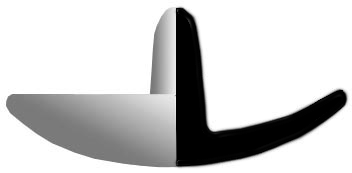 ANVIL. In paddle-and-anvil pottery-making, the tool that provides a passive, convex surface opposite the paddle, usually held on the inner surface of the vessel. Aboriginal southern California potters manufactured mushroom-shaped ceramic anvils, as well as using smooth stones, baskets, and pots as anvils.
ANVIL. In paddle-and-anvil pottery-making, the tool that provides a passive, convex surface opposite the paddle, usually held on the inner surface of the vessel. Aboriginal southern California potters manufactured mushroom-shaped ceramic anvils, as well as using smooth stones, baskets, and pots as anvils.APPLIQUÉ. A form of decoration produced by adding pieces of clay to the surface of a vessel.
ATTRITION. The coarseness or fineness of the prepared clay used in ceramics.
BARSTOW BUFF. A series, found in the Mojave Desert from Barstow to the Colorado River. The Barstow series has been classified within Lower Colorado buff ware and consists of the Pyramid gray type. It was identified by Albert H. Schroeder. (Schroeder 1958)
BEAD. See ornament.
BLACK MESA BUFF. Buff and red-on-buff types, characterized in part by scarce inclusions and the presence of unpulverized clay. Black Mesa buff appears to have been manufactured on the lower Colorado River above and below Yuma. It has been assigned to the Patayan I period (ca. A.D. 700-1000). Black Mesa buff is similar in most respects to Tumco buff. It has been classified within the Palo Verde series and Lower Colorado buff ware. The types were distinguished by Malcolm J. Rogers, and they were published by Albert H. Schroeder and Michael R Waters. (Schroeder 1958; Waters 1982a, 1982b, 1982c)
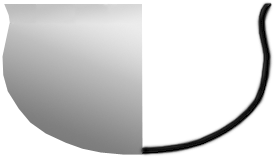 BOWL. A vessel of appreciable height, with a diameter at the mouth that is equal, or nearly equal, to the vessel's maximum diameter; relatively tall bowls have also been termed pots. According to Rogers, bowls were produced during Yuman I, II, and III periods, with recurved rather than direct rims in the second and third periods. (Rogers 1936, 1945)
BOWL. A vessel of appreciable height, with a diameter at the mouth that is equal, or nearly equal, to the vessel's maximum diameter; relatively tall bowls have also been termed pots. According to Rogers, bowls were produced during Yuman I, II, and III periods, with recurved rather than direct rims in the second and third periods. (Rogers 1936, 1945)BURNISHING. A form of surface treatment through intensive polishing, usually by rubbing with a smooth stone prior to firing. According to Rogers and Waters, burnishing was limited to Yuman/Patayan I ceramics. (Rogers 1945; Waters 1982a)
CAHUILLA BUFF. A type characterized in part by its fine, dense paste. Cahuilla buff is found in the Salton Basin and dated after ca. A.D. 1580. It has been classified within the Salton series and Lower Colorado buff ware. The type was described by Ronald V. May. (May 1978, 2001)
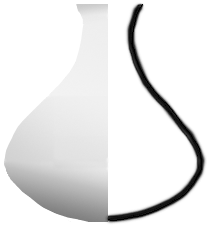 CANTEEN. A ceramic vessel, generally globular in shape and with a small-diameter mouth, but smaller in size than an olla; sometimes characterized as a variety of jar. According to Rogers, canteens were produced during Yuman I, II, and III periods, with recurved rather than direct rims in the second and third periods. (Rogers 1945)
CANTEEN. A ceramic vessel, generally globular in shape and with a small-diameter mouth, but smaller in size than an olla; sometimes characterized as a variety of jar. According to Rogers, canteens were produced during Yuman I, II, and III periods, with recurved rather than direct rims in the second and third periods. (Rogers 1945)CARBON STREAK. A black or gray streak in the core of a pottery vessel wall, exposed in the broken edge of a sherd; produced by incomplete oxidation of the carbon in the clay during firing.
CARRIZO BUFF. A series and types, including Carrizo buff, Carrizo red-on-buff, and Carrizo stucco. The series and types are associated with the western Salton Basin, including Carrizo Gorge. Carrizo buff type has been dated to ca. A.D. 1150-1580. The Carrizo series has been classified within Lower Colorado buff ware. The series includes Carrizo, Vallecitos, and Soda types. Chronologically successive Carrizo I and Carrizo II types have also been distinguished. The series and types were initially defined by Malcolm J. Rogers and published by Ronald V. May and Gena R. Van Camp. (May 1978, 2001; Van Camp 1979)
CERAMICS. Clay artifacts that have been shaped and then heated sufficiently to harden them irreversibly; including pottery, figurines, pipes, rattles, anvils, and other objects.
CLAY. The fine-grained material that is plastic when mixed with water but irreversibly hardened when fired. In geological usage, clay can refer either to materials of a certain particle size (e.g., diameter less than 3.9 microns) or else to specific mineral types (especially kaolin, montmorillonite, and illite).
COACHELLA BROWN. A type characterized in part by fine temper with only traces of mica. Coachella brown is found in the Coachella Valley of eastern Riverside County. It has been classified within the Gulf series and Tizon brown ware. Malcolm J. Rogers identified the type, which was described and published by Ronald V. May. (May 1978; Van Camp 1979)
COFFEE BEAN EYE. Representation of an eye by a protruding oval that is crossed by a horizontal groove; a frequent element of human effigy figurines in southern California.
COIL. A tubular piece of ceramic paste, used to build up the body of a pottery vessel.
COLORADO BUFF. Buff, red-on-buff, beige, red-on-beige, and red types. The Colorado types have been classified within Lower Colorado buff ware. Colorado beige, red-on-beige, and red types have been characterized in part by their distinctive color and abundant temper. They are found in the lower Colorado River valley from north of Blythe to Yuma, and have been assigned to the Patayan I period (ca. A.D. 700-1000). Colorado red has a burnished red clay slip. These three types have sometimes been included within the Parker series. Colorado buff and red-on-buff have been characterized in part by fine inclusions, thin walls, and hard fracture. These two types are found on the lower Colorado River and in the California desert, and have been assigned to the Patayan III period (after ca. A.D. 1500). The types were identified by Malcolm J. Rogers, and they were described and published by Albert H. Schroeder and Michael R. Waters. (Schroeder 1958; Waters 1982a, 1982b, 1982c)
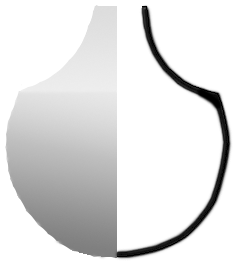 COLORADO SHOULDER. A relatively abrupt change of slope where the vessel neck meets the vessel body, found in ollas and jars. According to Rogers and Waters, the Colorado shoulder is diagnostic of the Yuman/Patayan I period. (Rogers 1945; Waters 1982a)
COLORADO SHOULDER. A relatively abrupt change of slope where the vessel neck meets the vessel body, found in ollas and jars. According to Rogers and Waters, the Colorado shoulder is diagnostic of the Yuman/Patayan I period. (Rogers 1945; Waters 1982a)CONCENTRATION. Sorting of ceramic raw material after crushing and reduction; accomplished aboriginally using a basketry parching tray. (Rogers 1936)
CRONESE BROWN. A type characterized in part by coarse inclusions of colored feldspar. Cronese brown has been found in the central Mojave Desert, including the Cronese Basin. A chronological placement in the Yuman II period (ca. A.D. 1000-1500) has been suggested. The type has been classified within the Mojave series and Tizon brown ware. It was described by Malcolm J. Rogers and published by Ronald V. May. (May 1978)
CRUCERO BROWN. A type characterized in part by its fine paste and temper. Crucero brown is found in the Mojave sink area of the central Mojave Desert. A chronological placement between ca. A.D. 1100 and 1450 has been suggested. The type has been classified within the Mojave series and Tizon brown ware. It was described by Malcolm J. Rogers and published by Ronald V. May. (May 1978)
CRUSHING. The initial stage in working source material for ceramics, accomplished by pounding in a metate or mortar, or on the ground. (Rogers 1936)
DISK. A small, circular ceramic object with ground edges and sometimes perforations; sometimes made to patch a broken vessel.
DRILLED HOLE. A small hole piercing the wall of a ceramic vessel, created either before or after firing; most commonly observed near the rim and interpreted as having been created to repair a partially cracked vessel by binding across the crack.
EFFIGY. See figurine.
FABRIC. Fired ceramic material, including clay and inclusions but excluding surface additions such as paint and slips.
FIGURINE. A nonutilitarian ceramic object, such as an effigy. According to Rogers, effigies were made during all three Yuman periods, but were rare in Yuman I. (Rogers 1945)
FIRE CLOUD. A localized darkened area on the surface of a ceramic object, often produced by contact between objects during firing; variously considered to be either undesirable or decorative.
FIRE CRACKING. Fine cracks on the surface of a ceramic object, produced by rapid firing.
FIRING. Heating a clay object to the point at which water is driven off and irreversible hardening occurs, above about 400-500oC.
FRACTURE. The way in which a sherd breaks; for instance, hard, soft, sharp, crumbly.
FUGITIVE. A coat or painted design that is relatively unstable or impermanent, because it was applied after firing or did not reach sufficient temperature during firing.
GROG. Sometimes used as synonymous with inclusions; sometimes limited specifically to inclusions of crushed sherds.
GULF BROWN. A series distinguished around the shoreline of Lake Cahuilla in the Salton Basin as well as farther south on the Gulf of California in Baja California and Sonora. The Gulf series is classified within Tizon brown ware, and includes Coachella, Salton, San Felipe, and Seri types. The series was described and published by Ronald V. May. (May 1978)
HAKATAYA. A late prehistoric pattern in southeastern California and western Arizona, dated after ca. A.D. 700; usually synonymous with Yuman or Patayan.
HAKUM BROWN. A type characterized in part by its light, reddish color and abundant mica inclusions. Hakum brown is found particularly in the Jacumba area of northern San Diego County and northern Baja California, and has been dated to after ca. A.D. 1000. It has been classified within the Peninsular series and Tizon brown ware. The type was distinguished by Malcolm J. Rogers. It was described and published by Ronald V. May and, more briefly, by Gena R. Van Camp. (May 1978, 2001; Meighan 1959; Van Camp 1979)
HANDLE. A projection for holding. According to Rogers and Waters, lug handles and loop handles were rare during the Yuman/Patayan I period and absent from Yuman/Patayan II and III. Tab handles were present on Yuman II and III scoops, according to Rogers. (Rogers 1945; Waters 1982a)
HARDNESS. Usually used to refer to ranking in the Mohs hardness scale, based on ability either to scratch or else to be scratched by standard minerals.
INCISING. A form of decoration created by linear indentations, for instance in the form of lip notching or more elaborate patterns on the neck or body of a vessel. According to Rogers and Waters, incising was limited to Yuman/Patayan I ceramics. (Rogers 1945; Waters 1982a)
INCLUSION. A non-plastic material (e.g., a mineral crystal, rock fragment, sherd, shell, etc.), either occurring naturally as an impurity within the clay or intentionally added as temper to control damage from shrinking during firing; also sometimes termed grog.
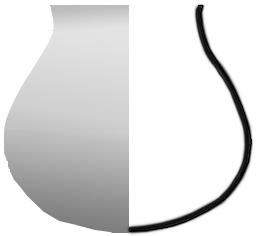 JAR. A globular vessel, sometimes distinguished from an olla by a mouth of moderate diameter; sometimes a term encompassing ollas and canteens. According to Rogers, jars were produced during Yuman I, II, and III periods, with recurved rather than direct rims in the second and third periods. Rogers also distinguished seed jars, apparently on the basis of their smaller mouths. (Rogers 1945)
JAR. A globular vessel, sometimes distinguished from an olla by a mouth of moderate diameter; sometimes a term encompassing ollas and canteens. According to Rogers, jars were produced during Yuman I, II, and III periods, with recurved rather than direct rims in the second and third periods. Rogers also distinguished seed jars, apparently on the basis of their smaller mouths. (Rogers 1945)KILN. A feature within which ceramics were fired. Locally, this was likely to be a shallow pit.
KNEADING. Working moist clay by hand to distribute water and inclusions uniformly and to eliminate air bubbles.
LADLE. See scoop.
LAGUNA BROWN. A series distinguished in the vicinity of Mount Laguna in southeastern San Diego County. The Laguna series has been classified within Tizon brown ware and is composed of Sentenac and Pine Valley types. The series was described by Ronald V. May. (May 1978)
LA PAZ BUFF. A series, found on the lower Colorado River above Yuma. The La Paz series has been classified within Lower Colorado buff ware and includes Needles types. It was described by Albert H. Schroeder. (Schroeder 1958)
LID. A round ceramic disk used to cover the mouth of a cessel.
 LIP. The edge of a vessel's mouth at its rim. Lip types may include flat, rounded, beveled, and folded. According to Rogers, lips were rounded during the Yuman I period and flat during the Yuman II and III periods. Also according to Rogers, lip incising was a Yuman I trait, and a reinforcing or folded lip band was a Yuman II and III trait. (Rogers 1945; Van Camp 1979:58)
LIP. The edge of a vessel's mouth at its rim. Lip types may include flat, rounded, beveled, and folded. According to Rogers, lips were rounded during the Yuman I period and flat during the Yuman II and III periods. Also according to Rogers, lip incising was a Yuman I trait, and a reinforcing or folded lip band was a Yuman II and III trait. (Rogers 1945; Van Camp 1979:58)LOWER COLORADO BUFF. A ware, sometimes alternatively termed Lower Colorado River buff ware, which has been characterized in part by paddle-and-anvil shaping, the use of sedimentary clays, and generally light color. Various series have sometimes been distingished within the ware, including Parker, Palo Verde, Salton, La Paz, Barstow, Carrizo, Gila Bend, and Lower Gila. The ware was identified by Malcolm J. Rogers, and it was described by Albert H. Schroeder, Ronald V. May, and Michael R. Waters. (May 1978, 2001; Schroeder 1958; Waters 1982a, 1982b, 1982c)
MOJAVE BROWN. A series distinguished in the Mojave Desert. The Mojave series has been classified within Tizon brown ware. Types composing the series include Cronese, Crucero, and Panamint. The series was described by Ronald V. May. (May 1978)
MOLD. An inverted pot or basket on which clay was applied to shape the base of a ceramic vessel. According to Rogers, basket molding was only used during the Yuman I period. (Rogers 1936, 1945)
NECK. The portion of a pot below the rim but above the main body.
NEEDLES BUFF. Buff, red-on-buff, beige, red-on-beige, red, black-on-red, and stucco types, characterized in part by fine inclusions of quartz sand and potsherds. The Needles types have been found on the lower Colorado River above Yuma, including the area around the town of Needles. They have been classified as the La Paz series within Lower Colorado buff ware. The types were described by Albert H. Schroeder. (Schroeder 1958)
NEUTRON ACTIVATION ANALYSIS. A method for identifying the relative concentrations of specific elements present in ceramic objects. See also x-ray fluoresence analysis.
NOTCHING. See incising.
OCOTILLO BUFF. A type characterized in part by its waxy, blocky paste. Ocotillo buff has been identified in Anza-Borrego Desert State Park, in eastern San Diego County, and dated to after ca. A.D. 1150. It has been classified within the Salton series and Lower Colorado buff ware. The type was described by Ronald V. May. (May 1978, 2001)
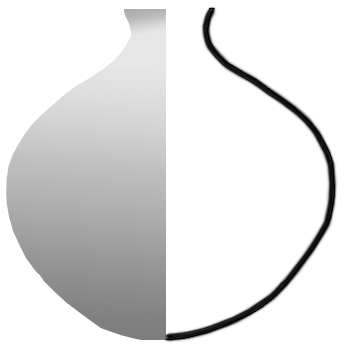 OLLA. A relatively large, globular ceramic vessel, used for cooking, storage, or holding a cremation; sometimes classified as a jar; smaller vessels that are similar in shape have been termed canteens. According to Rogers, ollas were produced during Yuman I, II, and III periods, with wider mouths and recurved rather than direct rims during the second and third periods. (Rogers 1945)
OLLA. A relatively large, globular ceramic vessel, used for cooking, storage, or holding a cremation; sometimes classified as a jar; smaller vessels that are similar in shape have been termed canteens. According to Rogers, ollas were produced during Yuman I, II, and III periods, with wider mouths and recurved rather than direct rims during the second and third periods. (Rogers 1945)ORNAMENT. A decorative ceramic object with one or more holes for attachment, such as a bead or pendant.
OXIDIZING. Firing of ceramics under conditions in which there is sufficient exposure to atmospheric oxygen to chemically alter carbon and iron in the objects' paste, tending to produce reddish coloring of the fired material; contrasted with reducing.
PADDLE. In paddle-and-anvil pottery making, the tool (usually wooden) used to strike the surface of a vessel that is being shaped, in order to merge the coils of the paste.
PAINTING. Surface decoration by applying pigments in patterns; usually done prior to firing.
PALOMAR BROWN. A type found particularly in the Palomar Mountain area of northern San Diego County, classified within the Peninsular series and Tizon brown ware. Palomar brown was also termed Piñon brown by Malcolm J. Rogers. The type was described by Clement W. Meighan and Ronald V. May. (May 1978; Meighan 1959)
PALO VERDE BUFF. A series, characterized by inclusions of potsherds or unpulverized clay. The series includes Tumco and Black Mesa types. It is found in the Colorado River valley from north of Palo Verde valley to Yuma. The Palo Verde series has been classified within Lower Colorado buff ware. The series was described by Albert H. Schroeder. (Schroeder 1958).
PARCHER. See tray.
PARKER BUFF. A series and types, characterized in part by small to medium inclusions of quartz and feldspar. The series includes Parker buff, Parker red-on-buff, Parker black-on-red, Parker stucco, Colorado beige, Colorado red-on-beige, and Colorado red types. The series has been classified in Lower Colorado buff ware and sometimes assigned to the Patayan II and III periods (post ca. A.D. 1000). It is found in the Colorado River valley north of Yuma, particularly in Parker Valley. The types were defined by Malcolm J. Rogers, and they were described and published by Albert H. Schroeder and Michael R. Waters. (Schroeder 1958; Waters 1982a, 1982b, 1982c).
PASTE. The principal material composing ceramics, including clay and non-plastic inclusions but excluding surface applications.
PATAYAN. A late Holocene period or pattern, dated to after ca. A.D. 700. Patayan is essentially synonymous with Yuman and Hakataya. Three successive phases of Patayan have commonly been recognized, based primarily on changes in ceramic types and attributes: Patayan I (ca. A.D. 700-1000), Patayan II (ca. A.D. 1000-1500), and Patayan III (after ca. A.D. 1500). (Waters 1982a, 1982b, 1982c)
PENDANT. See ornament.
PENINSULAR BROWN. A series found in the Peninsular Range of southern California and northern Baja California, between Palomar Mountain and the Sierra Juárez. The series is included within Tizon brown ware. Types composing the series include San Diego, Palomar, and Hakum. The series was defined and published by Ronald V. May. (May 1978, 2001)
PERMEABILITY. The ability of a material to allow water or other liquids to pass through it; see also porosity.
PINCH POT. A vessel shaped by pinching a ball of clay, rather than being formed by coiling or molding.
PINE VALLEY. Red and gray types, distinguished from other brown types in part by their colors. Pine Valley red and Pine Valley gray are found in the Peninsular Range of southern California and northern Baja California, centered on Pine Valley. The types have been classified within the Laguna series and Tizon brown ware. They were described by Ronald V. May. (May 1978)
PIÑON BROWN. A type found in northern San Diego County, particularly around the Piñon Mountains. Piñon brown has been classified within Tizon brown ware. It may be essentially equivalent to Hakum brown and Palomar brown. The type was distinguished by Malcolm J. Rogers, and a brief description was published by Gena R. Van Camp. (Van Camp 1979)
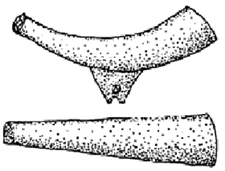 PIPE. A ceramic artifact used to smoke tobacco. Common forms in southern California are straight or conical pipes and bow pipes. According to Rogers, pipes were limited to the Yuman I period. (Rogers 1936, 1945)
PIPE. A ceramic artifact used to smoke tobacco. Common forms in southern California are straight or conical pipes and bow pipes. According to Rogers, pipes were limited to the Yuman I period. (Rogers 1936, 1945)POROSITY. The density of small cavities within the body of a ceramic object; see also permeability. Pores may be created by the combustion of organic inclusions during firing.
POT. See bowl.
POTTERY. Ceramic objects that are constructed specifically in the form of vessels.
PUNCTATION. A manner of decorating ceramics with patterns of small holes or indentations.
PYRAMID GRAY. A type characterized in part by its color and large inclusions of quartz and biotite. Pyramid gray has been found in the Mojave Desert between Barstow and the Colorado River, and dated to ca. A.D. 900-1150. It has been classified within the Barstow series and Lower Colorado buff ware. The type was described by Harold S. Colton and Albert H. Schroeder. (Colton 1939; Schroeder 1958)
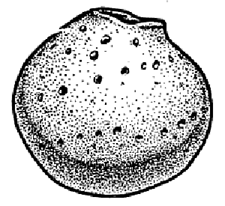 RATTLE. A small, globular ceramic form, with perforations and a wooden handle; relatively uncommon. (Rogers 1936)
RATTLE. A small, globular ceramic form, with perforations and a wooden handle; relatively uncommon. (Rogers 1936)REDUCING. Firing of ceramics under conditions in which there is not sufficient exposure to atmospheric oxygen to chemically affect all of the carbon and iron in the objects' paste, tending to produce a grayish coloring of the fired material; contrasted with oxidizing.
REDUCTION. The second stage in preparing clay for use in ceramics, consisting of fine grinding in a metate or mortar, following crushing and prior to concentration. (Rogers 1936)
RESIDUAL. Applied to clay that has essentially weathered in place from underlying bedrock; commonly containing more abundant, poorly sorted natural inclusions as compared with sedimentary clay.
 RIM. The upper portion of a ceramic vessel at and adjacent to its mouth, including the lip. According to Rogers, rims were direct rather than recurved on all forms during the Yuman I period; on seed jars, some scoops, and some trays during the Yuman II period; and on some scoops and trays during the Yuman III period. According to Waters, jar rims were direct during the Patayan I period and recurved during Patayan II and III. According to Rogers and Waters, rim incising was a Yuman/Patayan I trait. Rogers asserted that reinforcing rim bands were a Yuman II and III trait, but Waters suggested that reinforced rim bands were absent during the Patayan II period. (Rogers 1945; Waters 1982a)
RIM. The upper portion of a ceramic vessel at and adjacent to its mouth, including the lip. According to Rogers, rims were direct rather than recurved on all forms during the Yuman I period; on seed jars, some scoops, and some trays during the Yuman II period; and on some scoops and trays during the Yuman III period. According to Waters, jar rims were direct during the Patayan I period and recurved during Patayan II and III. According to Rogers and Waters, rim incising was a Yuman/Patayan I trait. Rogers asserted that reinforcing rim bands were a Yuman II and III trait, but Waters suggested that reinforced rim bands were absent during the Patayan II period. (Rogers 1945; Waters 1982a)SALTON BROWN. A ware or type, characteristic of the Salton Basin in Imperial and Riverside counties. Malcolm J. Rogersís unpublished notes and collections at the San Diego Museum of Man identified a Salton brown type. Ronald V. May described Salton brown within the Gulf series of Tizon brown ware. Gena R. Van Camp published extracts from Rogersís notes, including a brief description of the Salton brown type. John A. Hildebrand and his associates used petrographic and chemical methods to distinguish Salton brown as a desert ware distinct from Tizon brown manufactured in the mountains to the west. (Gallucci 2001, 2004; Hildebrand et al. 2002; May 1978, 2001; Van Camp 1979)
SALTON BUFF. A series and types characteristic of the Salton Basin in Imperial and Riverside counties. Malcolm J. Rogersís unpublished notes and collections at the San Diego Museum of Man identified Salton buff, Salton red-on-buff, and Salton stucco types. Albert H. Schroeder described the Salton series within Lower Colorado buff ware as including Topoc types. Ronald V. May described Salton buff and Salton red-on-buff types, dated to ca. A.D. 1150-1350, within the Salton series (which also includes Cahuilla buff and Ocotillo buff) and Lower Colorado buff ware. Waters described Salton buff and Salton red-on-buff types, attributed to the Patayan II period (ca. A.D. 950-1500) and characterized by lacustrine clay tempered with beach sand. (May 1978, 2001; Schroeder 1958; Waters 1982a, 1982b, 1982c)
SAND HILLS. Ceramic types in southeastern Imperial County. Four types were proposed by Stuart L. Peck: Sand Hills red, Sand Hills gray, Sand Hills black-in-red, and Sand Hills cream-in-black. (Peck 1953)
SAN DIEGO BROWN. Types found in San Diego County and northern Baja California and dated to after ca. A.D. 1000. Three types, San Diego brown I, San Diego brown II, and San Diego red-on-brown, have been distinguished. San Diego brown has been classified within the Peninsular series and Tizon brown ware. San Diego brown was identified by Malcolm J. Rogers, and the types were described and published by Ronald V. May and Gena R. Van Camp. (May 1978, 2001; Van Camp 1979)
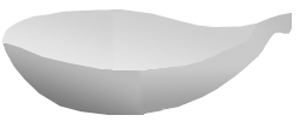 SCOOP. A relatively uncommon ceramic form, consisting of a small, shallow bowl and upturned handle. According to Rogers, scoops were produced during Yuman I, II, and III periods, adding recurved rims and tab handles in the second and third periods. (Rogers 1945)
SCOOP. A relatively uncommon ceramic form, consisting of a small, shallow bowl and upturned handle. According to Rogers, scoops were produced during Yuman I, II, and III periods, adding recurved rims and tab handles in the second and third periods. (Rogers 1945)SCUMMING. The movement of soluble salts, such as gypsum, to the surfaces of a vessel, producing a light, slip-like surface color.
SEDIMENTARY. Applied to clays that were deposited after significant erosional movement and natural sorting. Commonly containing less abundant natural inclusions as compared with residual clays.
SENTENAC BROWN. A type very similar to Salton brown. Sentenac brown is found on the eastern slope of the Peninsular Range in San Diego County. It has been classified within the Laguna series and Tizon brown ware. The type was identified by Malcolm J. Rogers. It was described and published by Ronald V. May and, more briefly, by Gena R. Van Camp. (May 1978; Van Camp 1979)
SERIES. A ceramic classificatory level, intermediate between ware and type.
SLIP. A form of surface modification consisting of a coat of clay and water, applied to change the object's color and surface texture, and perhaps to decrease its permeability; sometimes limited to coats that were applied prior to firing; see also wash. According to Rogers and Waters, red slips were used on Yuman/Patayan I ceramics but not Yuman/Patayan II or III ceramics. (Rogers 1945; Waters 1982a)
SODA BUFF. A type found in the Mojave Desert and dated to after ca. A.D. 900. Soda buff has been classified in the Carrizo series and Lower Colorado buff ware. The type was described by Ronald V. May. (May 1978)
SOURING. The process of storing wet clay for a prolonged period to improve its plasticity.
STUCCO. A form of surface treatment consisting of coarse, inclusion-rich clay applied to the outer surface of a cooking vessel prior to firing. According to Rogers and Waters, stucco finishing was absent from Yuman/Patayan I ceramics but present in Yuman/Patayan II and III ceramics. (Rogers 1945; Waters 1982a)
TEMPER. (as a noun) Non-plastic inclusions within a ceramic paste, usually referring to intentionally added inclusions but sometimes also referring to natural inclusions. (as a verb) To add inclusions to a paste; also, to work the wet paste in preparation to vessel shaping.
THIN-SECTION ANALYSIS. The study of ceramic fabrics using a thin slice of the material and a polarizing petrographic microscope to identify inclusions and textural features.
TIZON BROWN. A ware found in southern California as well as adjacent regions. Five series within Tizon have sometimes been distinguished: Peninsular, Laguna, Gulf, Mojave, and Sierra. The ware was initially identified by Lundon Hargrave and subsequently described by Harold S. Colton, Robert C. Euler and Henry F. Dobyns, and Ronald V. May, among others. Some investigators have challenged the appropriateness of applying the Tizon label to brown ceramics produced to the west of the Colorado Desert. Río del Tizón was a designation for the Colorado River in some early historical accounts. (Euler 1959; Euler and Dobyns 1958; Koerper and Drover 1983; Lyneis 1988; May 1978, 2001)
TOPOC BUFF. Buff, red-on-buff, fugitive red, and stucco types, characterized in part by abundant, coarse inclusions. Topoc buff has been classified within the Salton series and Lower Colorado buff ware and assigned to the Patayan II period (ca. A.D. 1000-1400). Its geographical range includes the lower Colorado River area and the Mojave Desert. The type was variously described by Harold S. Colton, Malcolm J. Rogers, Albert H. Schroeder, and Michael R. Waters. According to Waters, the type as it has been defined by Rogers and himself corresponds to Colton's Pyramid gray type, not Colton's Topoc buff type. (Colton 1939; Schroeder 1958; Waters 1982a, 1982b, 1982c)
 TRAY. A ceramic form with a relatively large diameter and low height; some trays were used for parching. According to Rogers, trays may have been absent in Yuman I times, had direct rims during the Yuman II period, and had direct and recurved rims during the Yuman III period. (Rogers 1936, 1945)
TRAY. A ceramic form with a relatively large diameter and low height; some trays were used for parching. According to Rogers, trays may have been absent in Yuman I times, had direct rims during the Yuman II period, and had direct and recurved rims during the Yuman III period. (Rogers 1936, 1945)TUMCO BUFF. Buff and red-on-buff types, characterized in part by scarce inclusions and the presence of unpulverized clay. Tumco buff appears to have been manufactured along the lower Colorado River between Blythe and the delta. It has been assigned to the Patayan II period (ca. A.D. 1000-1500). Tumco buff is similar in most respects to Black Mesa buff. It has been classified within the Palo Verde series and Lower Colorado buff ware. The types were distinguished by Malcolm J. Rogers and published by Michael R. Waters. (Waters 1982a, 1982b, 1982c)
TYPE. A taxon for ceramics that are assumed to be historically related and geographically restricted; often a subunit of a ware or a series; often defined by color, texture, form, or decoration.
VALLECITOS BUFF. Buff and red-on-buff types, characterized in part by their abundant, very fine inclusions. Vallecitos buff is found in the eastern Peninsular Range and western Salton Trough, in particular around Vallecitos Creek, and is dated between ca. A.D. 950 and 1580. It has been classified in the Carrizo series and Lower Colorado buff ware. The types were initially identified by Malcolm J. Rogers, and they were described and published by Ronald V. May. (May 1978, 2001)
WARE. A broad taxon for ceramics, often subsuming several types or series that are assumed to be historically related and geographically restricted; often defined by color, texture, and/or form.
WASH. A form of surface modification consisting of a thin clay coat to change color and/or texture; sometimes restricted to fugitive coats that were applied after firing. According to Rogers and Waters, a red wash was used on Yuman/Patayan I, II, and III ceramics. See also slip. (Rogers 1945; Waters 1982a)
WIPE. To alter the surface appearance of a ceramic object by lightly rubbing with the hand or a soft material prior to firing.
X-RAY DIFFRACTION ANALYSIS. A method for identifying specific minerals present in ceramic objects.
X-RAY FLUORESCENCE ANALYSIS. A method for identifying the relative concentrations of specific elements present in ceramic objects. See also neutron activation analysis.
YUMAN. The name of a linguistic family, also applied to an archaeological period or pattern, dated after ca. A.D. 500. The term is essentially synonymous with Hakataya and Patayan. Three phases have been distinguished, primarily on the basis of ceramic types and traits: Yuman I (ca. A.D. 600-800 to 1050), Yuman II (ca. A.D. 1050 to 1450-1500) and Yuman III (after ca. A.D. 1450-1500). (Rogers 1945)
Colton, Harold S.
1939 -- Prehistoric Culture Units and Their Relationships in Northern Arizona. Museum of Northern Arizona Bulletin No. 17. Flagstaff.
Euler, Robert C.
1959 -- Comparative Comments on California Pottery. University of California, Los Angeles, Archaeological Survey Annual Report 1958-1959:41-42.
Euler, Robert C., and Henry F. Dobyns
1958 -- Tizon Brown Ware: A Descriptive Revision. In Pottery Types of the Southwest, edited by Harold S. Colton. Museum of Northern Arizona Ceramic Series No. 3D. Flagstaff.
Gallucci, Karen Louise
2001 -- From the Desert to the Mountains: Salton Brownware Pottery in the Mountains of San Diego. Unpublished Master's thesis, Department of Anthropology, San Diego State University.
2004 -- Ceramic Analysis at Wikalokal, San Diego County (CA-SDI-4787). Proceedings of the Society for California Archaeology 14:119-123. (Online)
Hildebrand, John A., G. Timothy Gross, Jerry Schaefer, and Hector Neff
2002 -- Patayan Ceramic Variability: Using Trace Elements and Petrographic Analysis to Study Brown and Buff Wares in Southern California. In Ceramic Production and Circulation in the Greater Southwest: Source Determination by INAA and Complementary Mineralogical Investigations, edited by Donna M. Glowacki and Hector Neff, pp. 121-139. University of California, Los Angeles.
Koerper, Henry C., and Christopher E. Drover
1983 -- Chronology Building for Coastal Orange County: The Case from CA-ORA-119-A. Pacific Coast Archaeological Society Quarterly 19(2):1-34.
Lyneis, Margaret M.
1988 -- Tizon Brown Ware and the Problems Raised by Paddle-and-Anvil Pottery in the Mojave Desert. Journal of California and Great Basin Anthropology 10:146-155. (Online)
May, Ronald V.
1978 -- A Southern California Indigenous Ceramic Typology: A Contribution to Malcolm J. Rogers Research. Journal of the Archaeological Survey Association of Southern California 2(2):1-54.
2001 Ė- Ceramic Rims from the Rim of Lake Le Conte. In The Lake Le Conte Survey, by Lucille Ronan McCown, Gordon A. Clopine, Doris Hoover Bowers, Jay von Werlhof, Ruth DeEtte Simpson, Ronald V. May, and Pat King, pp. 45-72. San Bernardino County Museum Association Quarterly, Vol. 48, No. 3.
Meighan Clement W.
1959 -- Archaeological Resources of Borrego Desert State Park. University of California, Los Angeles, Archaeological Survey Annual Report 1958-1959:27-40.
Peck, Stuart L.
1953 -- Some Pottery from the Sand Hills, Imperial County, California: Site 4-Im-11. Archaeological Survey Association of Southern California Paper No. 1.
Rogers, Malcolm J.
1936 -- Yuman Pottery Making. San Diego Museum Papers No. 2.
1941 -- Aboriginal Culture Relations between Southern California and the Southwest. San Diego Museum Bulletin 5(3):1-6.
1945 -- An Outline of Yuman Prehistory. Southwestern Journal of Anthropology 1:167-198.
Schroeder, Albert H.
1958 -- Lower Colorado Buff Ware: A Descriptive Revision. In Pottery Types of the Southwest, edited by Harold S. Colton. Museum of Northern Arizona Ceramic Series No. 3D. Flagstaff.
Van Camp, Gena R.
1979 -- Kumeyaay Pottery: Paddle-and-Anvil Techniques of Southern California. Ballena Press Anthropological Papers No. 15. Socorro, New Mexico.
Waters, Michael R.
1982a -- The Lowland Patayan Ceramic Tradition. In Hohokam and Patayan: Prehistory of Southwestern Arizona, edited by Randall H. McGuire and Michael B. Schiffer, pp. 275-297. Academic Press, New York.
1982b -- The Lowland Patayan Ceramic Typology. In Hohokam and Patayan: Prehistory of Southwestern Arizona, edited by Randall H. McGuire and Michael B. Schiffer, pp. 537-570. Academic Press, New York.
1982c -- Ceramic Data from Lowland Patayan Sites. In Hohokam and Patayan: Prehistory of Southwestern Arizona, edited by Randall H. McGuire and Michael B. Schiffer, pp. 571-580. Academic Press, New York.